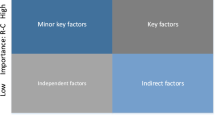Abstract
The fuzzy influence diagram is a kind of method recently developed for the risk analysis and evaluation, and it is welcome widely because of its visualization and understandability. In view of battlefield environment impacting on military operation effectiveness, this paper introduces the fuzzy influence diagram analysis method and constructs the analysis process based on fuzzy influence diagram for battlefield natural environment impacting on military operation effectiveness. An application example for one anti-terrorism operation using the fuzzy influence diagram evaluation method was given. The example analysis shows the effectiveness of the proposed method.








Similar content being viewed by others
References
Si-Jia, Z., Jian-Sheng, G., Fu, Z.: Multi-objective material provision mission planning under battlefield fuzzy environment. Math. Pract. Theory 45(13), 90–95 (2015)
Sun, W., Ma, J., Zhang, B., Wang, F., Liu, J.: Modeling and simulation of battlefield impact on warfare. In: National Annual Conference on system Simulation, Beijing, China (2003)
Xu, Y.M., Li, K.L., He, L.G., Zhang, L.X., Li, K.Q.: A hybrid chemical reaction optimization scheme for task scheduling on heterogeneous computing systems. IEEE Trans. Parallel Distrib. Syst. 26(12), 3208–3222 (2015)
Leake, T.L.A.: A method for evaluating the combat effectiveness of a tactical information system in a field army. Oper. Res. 19(3), 587–604 (1971)
Saaty, T.L.: Decision making for leaders. In: C3S2E Conference. ACM (1985)
Xu, Y.M., Li, K.L., Hu, J.T., Li, K.Q.: A genetic algorithm for task scheduling on heterogeneous computing systems using multiple priority queues. Inf. Sci. 270, 255–287 (2014)
Li, K.L., Tang, X.Y., Li, K.Q.: Energy-efficient stochastic task scheduling on heterogeneous computing systems. IEEE Trans. Parallel Distrib. Syst. 25(11), 2867–2876 (2014)
Xiao, G.Q., Li, K.L., Zhou, X., Li, K.Q.: Efficient monochromatic and bichromatic probabilistic reverse top-k query processing for uncertain big data. J. Comput. Syst. Sci. 89, 92–113 (2017)
Bilusich, D., Bowden, F.D.J., Gaidow, S.: Applying influence diagrams to support collective C2 in multinational civil-military operations. In: 16th International Command and Control Research and Technology Symposium. Washington, DC: DoD CCRP, pp. 1–22 (2011)
Howard, R.A., Matheson, J.E.: The Principles and Applications of Decision Analysis, vol. 2, pp. 720–762. Strategic Decisions Group, Menlo Park (1984)
Jensen, F.V., Nielsen, T.D., Shenoy, P.P.: Sequential influence diagrams: a unified asymmetry framework. Int. J. Approx. Reason. 42(1), 101–118 (2006)
Xiao, G.Q., Li, K.L., Li, K.Q.: Reporting l most influential objects in uncertain databases based on probabilistic reverse top-k queries. Inf. Sci. 405, 207–226 (2017)
Kwon, W.Y., Suh, I.H.: Planning of proactive behaviors for human–robot cooperative tasks under uncertainty. Knowl. Based Syst. 72, 81–95 (2014)
Howard, R.A., Matheson, J.E.: Influence diagrams. Decis. Anal. 2(3), 127–143 (2005)
Chen, Y.D., Li, K.L., Yang, W.D., Xiao, G.Q., Xie, X.H., Li, T.: Performance-aware model for sparse matrix–matrix multiplication on the sunway taihulight supercomputer. IEEE Trans. Parallel Distrib. Syst. 30(4), 923–938 (2019)
RodriGuez-Muniz, L.J., Lopez-DiAz, M., Gil, M.A.: Solving influence diagrams with fuzzy chance and value nodes. Eur. J. Oper. Res. 167(2), 444–460 (2005)
Zheng, H., Deng, Y., Hu, Y.: Fuzzy evidential influence diagram and its evaluation algorithm. Knowl. Based Syst. 131, 28–45 (2017)
An, N., Liu, J., Bai, Y.: Fuzzy influence diagrams: an approach to customer satisfaction measurement. In: International Conference on Fuzzy Systems and Knowledge Discovery IEEE, Haikou, China, pp. 24–27 (2007)
Zhou, X., Li, K.L., Yang, Z.B., Xiao, G.Q., Li, K.Q.: Progressive approaches for Pareto optimal groups computation. IEEE Trans. Knowl. Data Eng. 31(3), 521–534 (2018)
Chen, J.G., Li, K.L., Tang, Z., Yu, S., Li, K.Q.: A parallel random forest algorithm for big data in Spark cloud computing environment. IEEE Trans. Parallel Distrib. Syst. 28(4), 919–933 (2017)
Chen, Y.D., Xiao, G.Q., Yang, W.D.: Optimizing partitioned CSR-based SpGEMM on the sunway taihulight. Neural Comput. Appl. (2019). https://doi.org/10.1007/s00521-019-04121-z
Paffrath, U., Lemmerz, C., Reitebuch, O., Witschas, B., Nikolaus, I., Freudenthaler, V.: The airborne demonstrator for the direct-detection doppler wind lidar aladin on adm-aeolus. Part II: simulations and Rayleigh receiver radiometric performance. J. Atmos. Ocean. Technol. 26, 2516–2530 (2009)
Xiao, G.Q., Li, K.L., Li, K.Q., Zhou, X.: Efficient top-(k, l) range query processing for uncertain data based on multicore architectures. Distrib. Parallel Databases 33(3), 381–483 (2015)
https://news.qq.com/a/20151120/048700.htm. Available at 21 Nov 2018
Author information
Authors and Affiliations
Corresponding author
Rights and permissions
About this article
Cite this article
Shan, J., Liu, Q. Analysis of the Impact of Battlefield Environment on Military Operation Effectiveness Using Fuzzy Influence Diagram. Int. J. Fuzzy Syst. 21, 1882–1893 (2019). https://doi.org/10.1007/s40815-019-00662-6
Received:
Revised:
Accepted:
Published:
Issue Date:
DOI: https://doi.org/10.1007/s40815-019-00662-6




